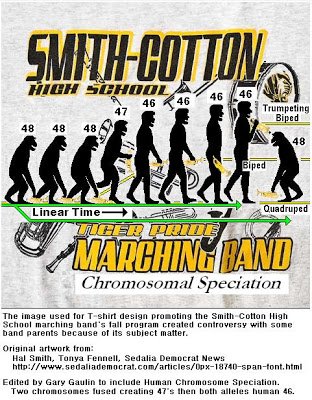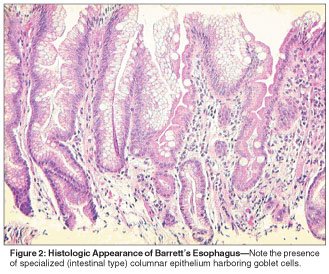There is something in our genome that makes us human and a chimp a chimp, what is it?
What do you think it is?
Here is what I think it is. Where is your explanation?
From:
http://theoryofid.blogspot.com/
Speciation
Speciation is a process which causes enough change in genotype or phenotype of an organism that they branch off from the lineage they once were to become a new "species" or "subspecies". In farming there are "breeds" of the cow species which are still able to interbreed with each other (but not always) and each a subspecies that can be given a unique scientific name. All cows are the same species, and each unique breed of cow is a separate subspecies.
To complicate the defining of a species some are different colors or are born with unique markings, yet they are all the same species and subspecies. Ants and bees are a good example where members of the same colony look entirely different depending on what they do.
Although it is sometimes very difficult or impossible to determine exactly where and when a "speciation event" occurred, the mechanisms that cause speciation can be listed as the following. In some cases speciation happens very slowly. In other cases it is immediate in which case there are no transitional forms, and there can be no transitional fossils.
Behavioral Speciation (very slow)
Speciation is in part guided by what the organism itself finds desirable in the variety available to select as a mate. This includes extreme examples such as peacocks where females selecting the largest most attractive tail design has led to males with giant brilliant displays, even though this makes it more difficult to fly from predators.
Although human speciation was chromosomal in origin, we have a similar intelligence guided mate selection preference. In magazine advertising the looks of "sex symbols" are sometimes computer enhanced to represent the conscious ideals not yet common in our morphology. What is added or removed from the picture helps show what human intelligence finds most desireable.
Geographic isolation can lead to behavioral speciation events. In the wild there is what are called "ring species" that slowly extended their territory in a direction that in time brings them back to where they started, forming a ring. By the time the ring forms a complete circle back again they are no longer able or no longer choose to breed with each other. In this case it is obvious that speciation occurred but there is no one place along the way where they suddenly changed, which then makes it impossible to find one single point along the way that they became a new subspecies (or possibly new species).
In behavioral speciation there is no one day and time that a pivotal event occurred, no single genome change resulted in a "speciation event" that created a new species. And the genome must first be already drifting in that direction or else such morphological change is impossible. In the peacock example we can say that the peacocks are aroused by the direction their genome is already set to go, anyway. Therefore what they in their mind find desirable is the same as what the genome finds desirable at the molecular level being expressed at the level of the emergent peacock brain. What they find desirable is not here hard-wired into neurons as an image or picture of what it should find desireable in a mate, it is an expression of the molecular genome itself that even responds chemically with hormones that cause physiological change where in humans just a picture of a desireable mate causes this molecular "arousal" to be produced.
Although all living things are at the mercy of climate change, volcanoes, earthquakes, floods, and other disasters we can to some degree predict where a species is drifting towards by how it idealizes itself. For our species there is all of art and culture where we find exaggerations of real life where the size of Betty Boops pupil alone is the size of her whole mouth yet we still recognize this image as being human and sexy. What produces this may be that it is possible for our genome to drift in that direction, or already is.
How long it would take an isolated genome to speciate depends on its genetic learning rate (how fast it gains or changes new information/genes). Sexual reproduction has a good amount of crossover exchange which greatly accelerates the ability to adapt and change. Asexual reproducers such as E. coli produce clones of itself which are identical to the parent. Fast responses to environment is then from exchanging plasmids but these are separate transient genomes, not the primary genome that accomplishes cell growth and reproduction.
There are "living fossils" that have changed so little it seems to us that they should have become a new species by now or at least new morphology. But this change is relative to how fast our genome changes in comparison to theirs. So it is not time alone that matters, we must also consider the genome learning rate in our consideration of how long it takes for a given genome to speciate.
Hybridization Speciation (immediate)
Common in plants and used in agriculture a hybrid species is produced when two species combine to form a new non-sterile species. In single cell organisms one species may retain all or part of its original form inside of the other (endosymbiosis). In complex animals hybridization can be more difficult. Horses and donkeys normally give birth to a sterile mule but on rare occasions a fertile mule is born.
Polyploid Speciation (immediate)
Polyploid speciation is the result of all chromosomes doubling, tripling or more in number. With twice or more of everything the cells are proportionately larger, resulting in a larger plant or animal. This is relatively common in self-reproducing plants. In animals reproducing the new genome structure requires a genome compatible mate, therefore surviving polyploidy species are less frequent but are still found in some insects, fishes, amphibians, reptiles and rat.[18] Paleopolyploidy is the scientific study of prehistoric polyploid speciation events.
Chromosome Speciation (fast - Human, Fruit Fly, Mosquito)
Chromosome fusion speciation[17] is the result of two chromosomes joining to become a single one such as the origin of human chromosome #2. Chromosome fission speciation is the result of a chromosome division.
In human chromosomal fusion speciation the telomeres at each end of the 2 supercoiled chromosomes became sticky, possibly by removal of the repeating code that forms a protective layer that makes the ends not-sticky. Then when not-sticky ends are in close enough proximity molecular forces of attraction take over then fusion occurs.
What causes telomeres to become not sticky to fuse like this, is not fully known. Phylogenetic evidence from the human genome indicates this has happened a number of times to increase chromosome complexity, along with extra copies of chromosomes being added to increase the number of chromosomes to increase total genome complexity. It is possible that through time an epigenetic mechanism has learned how to take good guesses this way, using an additional mechanism that when necessary prevents fusion by adding telomere repeat coding on ends to make not-sticky.
Fusion changes the locations of at least some of the chromosome territories that are formed upon uncoiling of the supercoiled chromosomes where each territory works as a single system, with neighboring specialized chromosome territory systems. The fusion event also scrambles some of the genes at each end as would be expected where there is a collision, and is evidenced at the fusion site of human chromosome number two where fragments from each side still embedded in the other. Even though there was not a significant amount of gene scrambling the rearranging of the chromosome territories may have already produced a noticeable morphological change. The mother of a child with this large a fusion might have been able to tell there was something unique about them but would be expected to still love them just the same, or more.
The fused chromosome is in either allele (either mother or father) of the haploid (has one of two sets of chromosomes) germ cell (egg or sperm) that divides down to develop into a 47 chromosome heterozygote (alleles are different not homozygous where alleles the same) humanoid that has the human chromosome #2 being expressed along with copy of the two chromosomes with no fusion that provides all that the cell had before, with something new in the fused copy for epigenetic systems to control to meet the needs of the growing cell. The fusion now replicates in the population as follows:
48 and 48 parents produce a 48 offspring only.
48 and 47 parents produce a 48 or 47 offspring.
47 and 47 parents produce a 48 or 47 or 46 human offspring.
47 and 46 parents produce a 47 or 46 human offspring.
46 and 46 parents produce a 46 human offspring only.
The first 46 chromosome humans who were born to the existing 47 chromosome lineage may have right away been fertile, or at first had sterility problems in which case human chromosome #2 had to first learn to survive to replicate without the unfused chromosomes of the other allele there to help maintain proper cell functions. It would then become increasingly difficult for a 46 to reproduce with 48 and possibly 47 in part because along with the new genome design came a new self-image that made the 48's look "apish" and 47's relatively "unattractive" to 46's.
Where "human" is defined as having the unique 46 chromosome genome design that separates us from 47 and 48 ancestors there was a first human couple in our ancestry that was already fully human. There is here a human man and a woman Chromosomal Adam and Eve who together could only produce 46 chromosome descendants whose children would prefer to be with their own kind as would their children's children through time, all the way from them to us.



